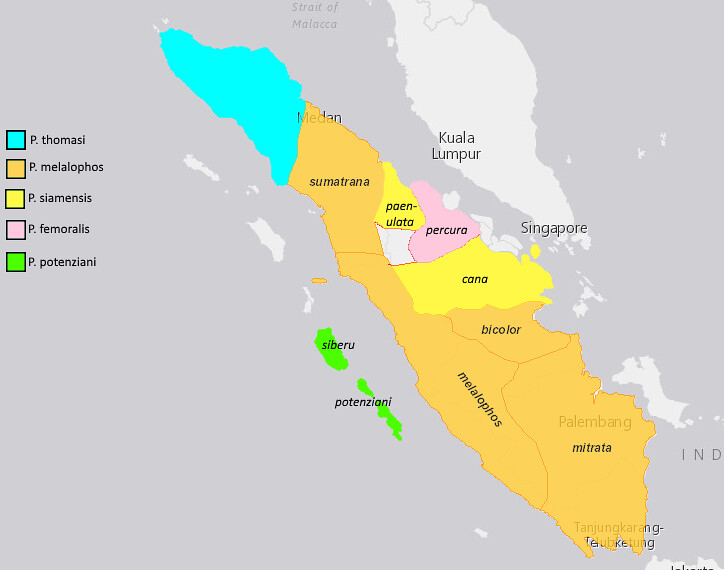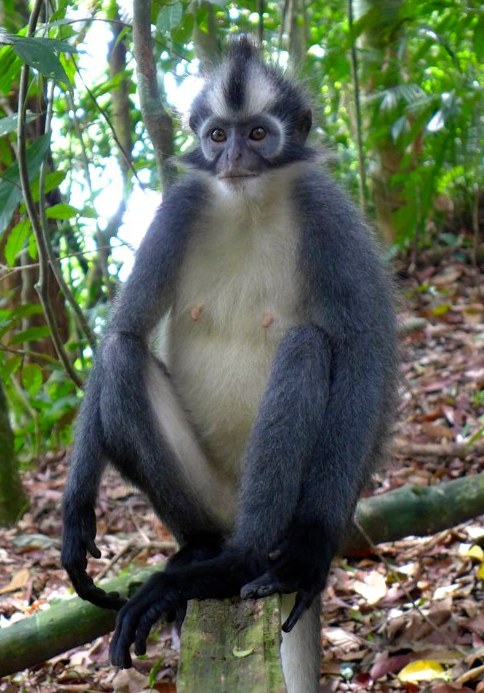The Presbytis genus of langur, known as surilis, are a genus of fruit-eating leaf monkeys, found mostly in Sumatra and Borneo.
In general, each area of Sumatra is home to only one surili species. This occurs because Sumatran surilis are generalist feeders, occupying the same ecological niche, and therefore each area can sustain only one species. In Borneo, however, several surili species occupy a single area, as poor soils in Borneo mean that primates occupy more specialised niches.
The boundaries between species are generally major rivers, which the monkeys cannot cross. There may be small areas of overlap between species.
The full list of Presbytis species is:
- Thomas' leaf monkey (Presbytis thomasi) - DNA evidence suggests that it is the oldest Presbytis species, having diverged from other Presbytis species around 8 million years ago. Found in Aceh, and North Sumatra. Its barriers are the Wampu river in North Sumatra, and the Alas river, as well as Lake Toba.
- The Sumatran surili (Presbytis melalophos), also known as the mitred leaf monkey (four subspecies in Sumatra, largely differentiated by their fur colour differences)
- The Javan surili (Presbytis comata), which is closely related to the South Sumatran subspecies (P. melalophos mitrata) of Sumatran surili
- The also related maroon langur (Presbytis rubicunda), which is found in Borneo, but is also closely related to the Sumatran surili
- The white-thighed surili (Presbytis siamensis). Four subspecies, found (P. siamensis siamensis) in peninsular Malaysia, (P. siamensis rhionis) in Pulau Bintang, (P. siamensis cana) in southern Riau province of Sumatra, and (P. siamensis paenulata) in northern Riau province of Sumatra. Ancestry unknown.
- The banded leaf monkey (Presbytis femoralis) - with three subspecies, two found in the Malayan peninsula, and one, P. femoralis percura, found between the Rokan and Siak rivers in the Pekanbaru area of Sumatra.
- The Mentawai langur (Presbytis poteziani) with two subspecies, both on the Mentawai islands. It shares an ancestor with the Sumatran/Javan surili.
- The white-fronted surili (P. frontata), Hose's langur (P. hosei) and the Sarawak surili (Presbytis chrysomelas) - three closely related species, all found on Borneo.
- The Natuna Island surili (Presbytis natunae). Ancestry unknown. Found on Natuna Besar island.

Map showing approximate distribution of Presbytis species in Sumatra (Malaysia, Singapore and Java are not shown).
Thomas Leaf Monkey

Thomas leaf monkey in Bukit Lawang
Thomas leaf monkey/Thomas langur is the northenmost Sumatran surili species. Its range is considered to be the land to the west of the Wampu river, and west of the Simpang Kiri river. The Wampu river rises on the eastern half of the Bukit Barisan range, near Berastagi, flowing north into the sea past Stabat, on the east coast of Sumatra, while the Simpang Kiri river rises on the western half of the Bukit Barisan range, flowing south into the sea at Singkil, on the west coast of Sumatra.
Thomas leaf monkeys live at altitudes of up to 2500m, but population densities decrease at higher altitudes. They range from west to east across the Bukit Barisan range, living in primary and secondary rainforest, as well as rubber plantations on their borders. The different populations of Thomas leaf monkeys from the west coast to east coast of Sumatra are somewhat isolated by the mountain range, and the Alas river, which runs down the centre of the Bukit Barisan range, blocking passage for most of its length. This means that individuals between west and east coast populations have some differences from each other.
Their preferred food is fruit, when available, and overall their diet consists of around 45% fruit, and 40% young leaves. Thomas's langurs spend most of their time feeding, or resting. Both female and male Thomas leaf monkeys weigh around 5-8kg. They reach sexual maturity at age five, and give birth to single young. They live to around 20 years.
Thomas leaf monkeys are born to females living in groups of between one and six females with a single male. The females in the group give birth to infants, and after around five years following the group's formation, when the infants have grown sufficiently large, the females leave the group, leaving the male and his sons, who will try to form groups of their own.
Infanticide has been recorded in several langur species, including Thomas' langurs. Infanticide occurs when a male attempts to kill the infants in a different group, in order to take over that group for himself. It is suggested that the relatively small group size of Thomas' langur (larger groups would otherwise provide more protection against predator species), is a defence against infanticide.